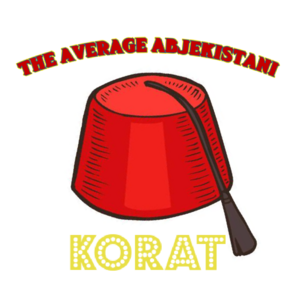Abjekistan
This article is incomplete because it is pending further input from participants, or it is a work-in-progress by one author. Please comment on this article's talk page to share your input, comments and questions. Note: To contribute to this article, you may need to seek help from the author(s) of this page. |
United Democratic Republics of Abjekistan Abzekiston Birlashgan Demokratik Respublikasi | |
|---|---|
Motto: Barchasi oltin quyosh ostida birlashgan ("All united under the golden sun") | |
| Capital | Noruzabad |
| Official languages | |
| Ethnic groups |
|
| Religion | Secular State
|
| Demonym(s) | Abjekistanian, Abjekistani |
| Government | Federal Parliamentary republic |
• President | Bakir Serat Komiliev |
• Prime Minister | Abel Bozukh |
• District Representatives | 152 Delegates |
• Municipality Representatives | 423 Delegates |
• Electors | The population |
| Independent state | |
• First Democratic elections | December 21th 1967 |
• Independence from Krenya | May 10th 1936 |
• Insurgencies against the Krenyan royalty | 1934-1936 |
• Abjekistan is declared Krenyan colony | 1765 |
• Abjekh-Krenyan war | 1757-1765 |
| Area | |
• Total | 2,053,679 km2 (792,930 sq mi) |
| Population | |
• January 2020 estimate | 65,722,000 |
| GDP (PPP) | 2020 estimate |
• Total | ~$357 billion |
| HDI (2019) | high |
| Currency | Puzhaks (ABP) |
| Driving side | right |
| Calling code | +151 |
| Internet TLD | .Ab |
Abjekistan, officially the United Democratic Republics of Abjekistan ( Abjekh: Abzekiston) is a Sovereign State in Central Thrismari. It is landlocked and is bordering Mehrava to the south-west, Encessia and Tulska to the South-East and The Great Golden Raj to the North. The South of the country, mostly the regions of Yădakstan and Günorta are known for being one of the cradles of civilization, with recent archaeological excavations dating the city of Aksaz to more than 10,000 years. The country actually consists of 6 semi-autonomous republics, very different from each other, but who share the same language and some similar traditions.
In the Abjekistani flag, the red fraction represents the socialist government and the blood of the people. it is also strategically placed at the top to represent the authority of the government. The white band represents the peace and purity, and the green represents the fertility and prosperity the Abjekistani land once had. Of course, the yellow sun represents the great, scorching Abjekh sun and the eagle is a steppe eagle, the national animal.
Etymology
Surprisingly, the word Abjekh does not originate from Abjekistan. The demonym was introduced by Krenyan colonialists in the 18th century after their conquest of the region. The name was formed after the name of the capital of the Yădakk Empire, Abjarankh, which was renamed Maztaransh in 1789 for obscure reasons.
History
Düýe Nomadic Tribes
TBA
The Three Kingdoms
TBA
Yădakk Empire
Its history dates back to the unification of the nomadic peoples of the north and center of the country by the Yădakk empire, which had developed enormously with its immense road network linking the desolate plateau of Khalee to the Margiric Gulf.
Krenian conquest
TBA
The City-State of Krenşäheri
Notice: this section is heavily Work-in-Progress, meaning that it is prone to important changes
The City-State of Krenşäheri is a micronation within Abjekistan, located on the coast of the Khizuz sea, in Günorta. It is not recognized as a sovereign state but more of a semi-autonomous state mostly controlled by Abjekistan. To enter the city, you need to have a valid passeport. Their currency is the Krenen.
Politics
Government
[DEPRECATED]
Abjekh Republics
| Flag | Name | Capital |
|---|---|---|
 |
Yădakstan¹ | Koshanda |
 |
Materikia | Korobankh |
 |
Düýestan | Sirmak |
 |
Günorta | Noruzabad (Khinalykh) |
 |
Kamelýa | Yerden |
 |
Cheburekia | Tarnov |
¹Yădakstan gained full independence in January 9th 2022
List of Ministries
- Ministry of Foreign Relations (AMFR)
- Ministry of Culture and Medias (AMCM)
- Ministry of the Automotive Industry (AMAI)
- Ministry of the Finance and Economy (AMFE)
- Ministry of Healthcare and Welfare (AMHW)
- Ministry of Defense (A-MD)
- Ministry of Education (A-ME)
- Ministry of the Transports (A-MT)
- Ministry of Justice (A-MT)
- Ministry of the National Militia (AMNM)
- Abjekistan Investigation Bureau (AIB)
Foreign Relations
Krenya
WIP
Foxomexra
WIP
Encessia
WIP
Mehrava
WIP
Culture
Festivals/celebrations
|17th of Apri| Halkfest, festival celebrating the uncommon multiculturalism of Abjekistan (Since 1989)
Music
Abjekhs love active and entertaining music, such as Bouzoukis, Kasatchoks and and traditional Yadakk music. The most popular dances are group dances, like the Koshandan line dance [1], which originates from the massive Thuadian immigration wave in the 1880s, and the Abjekh kick dance.
Fashion
The traditional Abjekh clothing may vary according to the regions, but the Abjekh outfit constitutes of a burgundy fez, a White Tchekeska, colored baggy pants and high boots for men. Women often wear the Perankh, a colorful dress decorated with golden flowers.
Medias
The region of Koshanda is recognized for its soap operas, musicals and humoristic programs. The most popular is certainly Korat, the average Abjekistani. Korat was a weekly humoristic television show produced from 1959 to 1992 recounting the hectic life of Korat Belmuth, a citizen of the small city of Sobu, located in the eastern Cheburek plains. A movie called Korat in Encessia was released in early 2021, and rumors of a sequel have come to our ears recently...
Industry
Automotive
Useful Links
-History of Abjekistan in a nutshell


